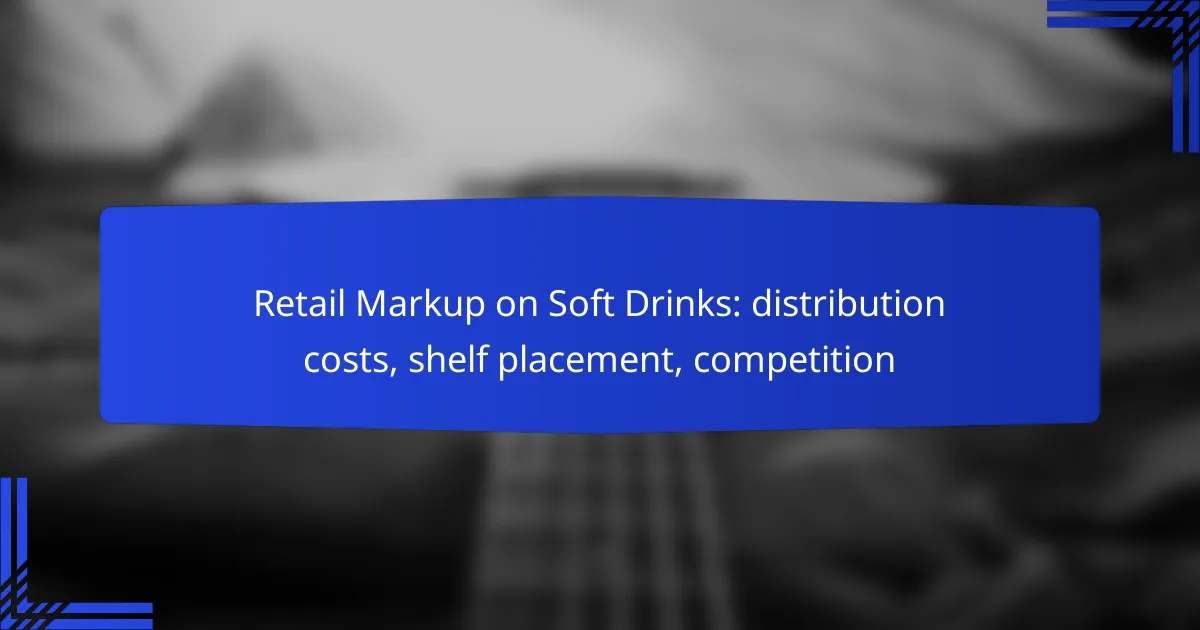Retail markup on soft drinks is a crucial aspect of pricing strategy in Australia, reflecting costs associated with distribution, shelf placement, and competitive dynamics. Factors such as the distance from production facilities, storage requirements, and retailer positioning play significant roles in determining the final price consumers encounter. Additionally, strategic shelf placement can enhance visibility and accessibility, further influencing sales and pricing. Understanding these elements is essential for both retailers and consumers navigating the soft drink market.

How does retail markup on soft drinks work in Australia?
Retail markup on soft drinks in Australia typically involves adding a percentage to the wholesale price to cover distribution costs, shelf placement, and competition. This markup can vary significantly based on factors like location and retailer strategy.
Understanding retail markup
Retail markup is the difference between the cost of acquiring soft drinks and the price at which they are sold to consumers. In Australia, this markup often ranges from 20% to 50%, depending on the retailer’s pricing strategy and market conditions.
Retailers calculate markup to cover expenses such as transportation, storage, and operational costs. A higher markup may be applied in premium locations or specialty stores, while discount retailers might opt for lower markups to attract price-sensitive customers.
Factors influencing markup rates
Several factors influence the markup rates on soft drinks in Australia. Distribution costs, including transportation and logistics, play a significant role, especially for products that require refrigeration or have a short shelf life.
Shelf placement is another critical factor; products placed at eye level or in high-traffic areas often command higher markups due to increased visibility and sales potential. Additionally, competition among retailers can lead to price adjustments, with some stores lowering their markups to remain competitive.
Comparison with other beverage categories
Soft drinks generally have a different markup structure compared to other beverage categories like alcoholic drinks or bottled water. For instance, alcoholic beverages often have higher markups, sometimes exceeding 100%, due to regulatory costs and demand factors.
Bottled water may have lower markups, typically around 15% to 30%, as it is often viewed as a commodity. Understanding these differences can help retailers strategically price their soft drink offerings in relation to other beverages in their inventory.
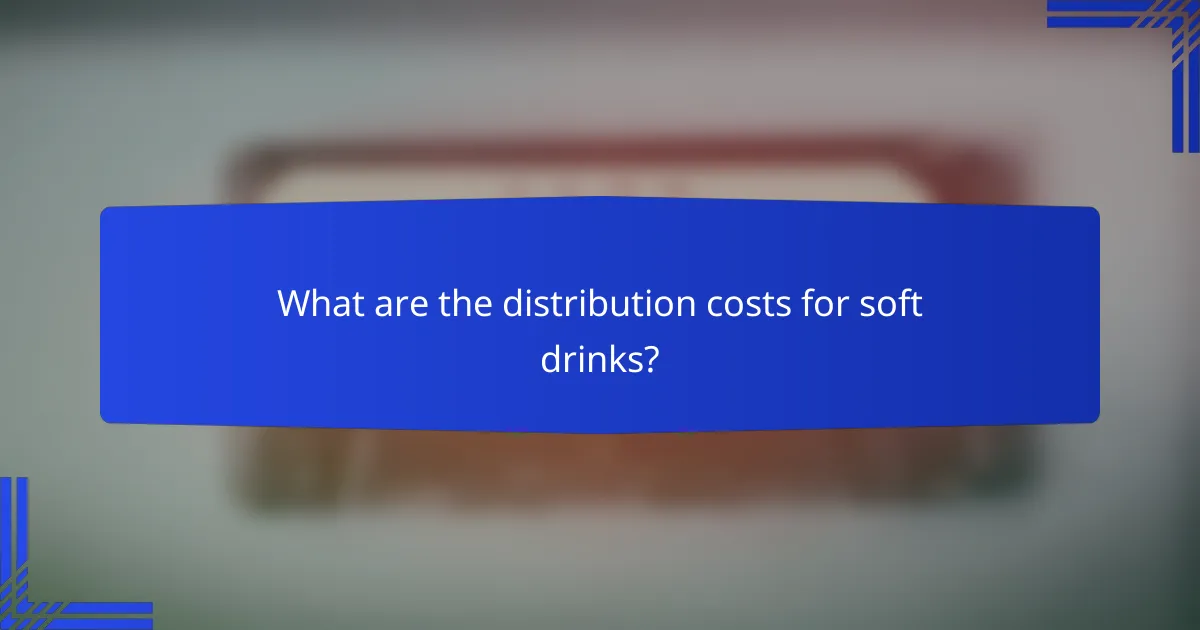
What are the distribution costs for soft drinks?
Distribution costs for soft drinks encompass various expenses incurred from the production facility to the retail shelf. These costs significantly influence the final price consumers pay and can vary based on factors such as distance, storage needs, and supplier contracts.
Transportation expenses
Transportation expenses are a major component of soft drink distribution costs, often accounting for a substantial percentage of the total. Factors such as distance from the manufacturing plant to the retailer, fuel prices, and the mode of transport (truck, rail, etc.) all impact these costs. For example, transporting goods over long distances typically results in higher expenses due to fuel and labor costs.
Retailers should consider local transportation options and routes to optimize delivery efficiency. Utilizing regional distribution centers can help reduce transportation costs by minimizing travel distances.
Storage and warehousing costs
Storage and warehousing costs involve expenses related to holding soft drink inventory before it reaches retail shelves. These costs can include rent for warehouse space, utilities, and labor for managing inventory. Depending on the region, warehousing costs can vary significantly, with urban areas typically being more expensive than rural locations.
Effective inventory management strategies, such as just-in-time delivery, can help minimize storage costs. Retailers should also evaluate their warehousing needs based on sales forecasts to avoid overstocking and associated costs.
Impact of supplier agreements
Supplier agreements can greatly influence distribution costs for soft drinks. Negotiated terms regarding pricing, delivery schedules, and payment conditions can either mitigate or exacerbate overall expenses. Long-term contracts may offer stability in pricing but could limit flexibility in responding to market changes.
Retailers should regularly review supplier agreements to ensure they are getting competitive rates and favorable terms. Building strong relationships with suppliers can also lead to better negotiation outcomes and potential cost savings.
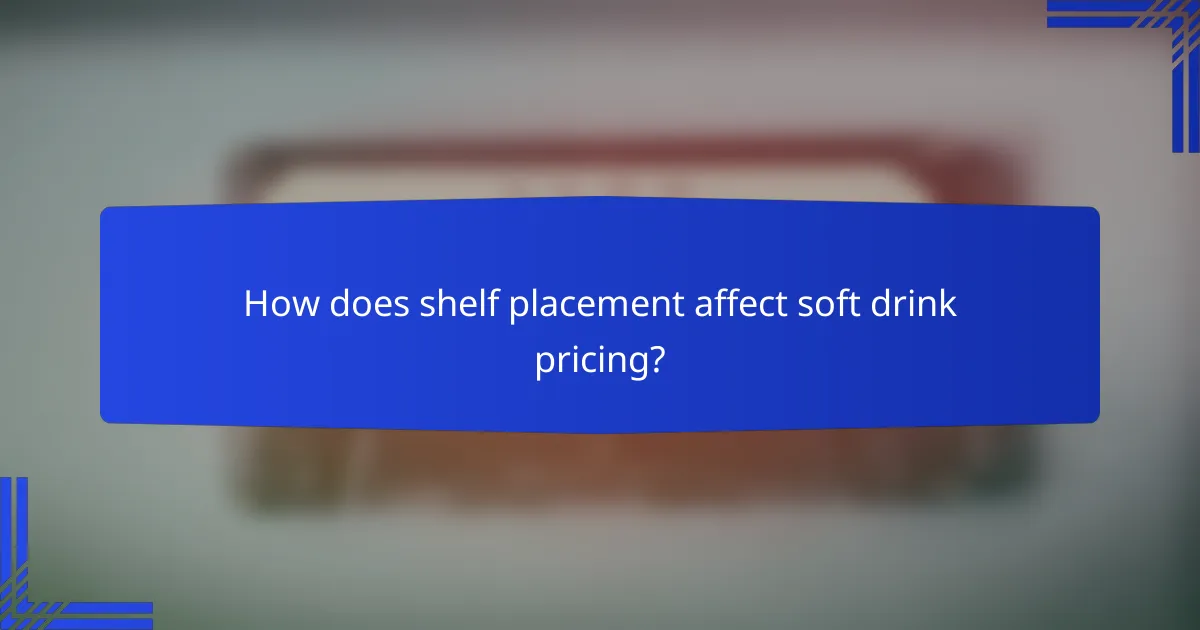
How does shelf placement affect soft drink pricing?
Shelf placement significantly influences soft drink pricing by affecting visibility and accessibility, which can drive sales. Products placed at eye level or in high-traffic areas often command higher prices due to increased consumer attention and demand.
High-traffic areas and visibility
Soft drinks positioned in high-traffic areas, such as near checkout counters or at the end of aisles, typically see higher sales volumes. This visibility allows retailers to charge a premium, as consumers are more likely to make impulse purchases in these locations.
For example, a soft drink brand placed at eye level in a busy supermarket can lead to sales increases of 20-30% compared to those on lower or less visible shelves. Retailers often leverage this strategy to maximize revenue from popular brands.
Influence of promotional displays
Promotional displays can significantly impact soft drink pricing by drawing attention and encouraging bulk purchases. Retailers often use temporary price reductions or bundled offers to entice customers, which can lead to increased sales and higher overall margins.
For instance, a soft drink brand featured in a prominent promotional display may see a price drop of 10-15% during a sales event, attracting more buyers. Retailers benefit from this strategy by moving inventory quickly while consumers enjoy perceived savings.
Retailer negotiation strategies
Retailers often negotiate shelf placement with soft drink manufacturers, influencing pricing strategies. Brands willing to pay higher slotting fees or provide promotional support may secure prime shelf space, allowing them to set higher prices based on increased visibility.
Negotiation tactics can include offering exclusive promotions or loyalty programs to retailers, which can enhance the perceived value of the product. Brands that effectively negotiate shelf placement can achieve better pricing power and increased market share in competitive environments.
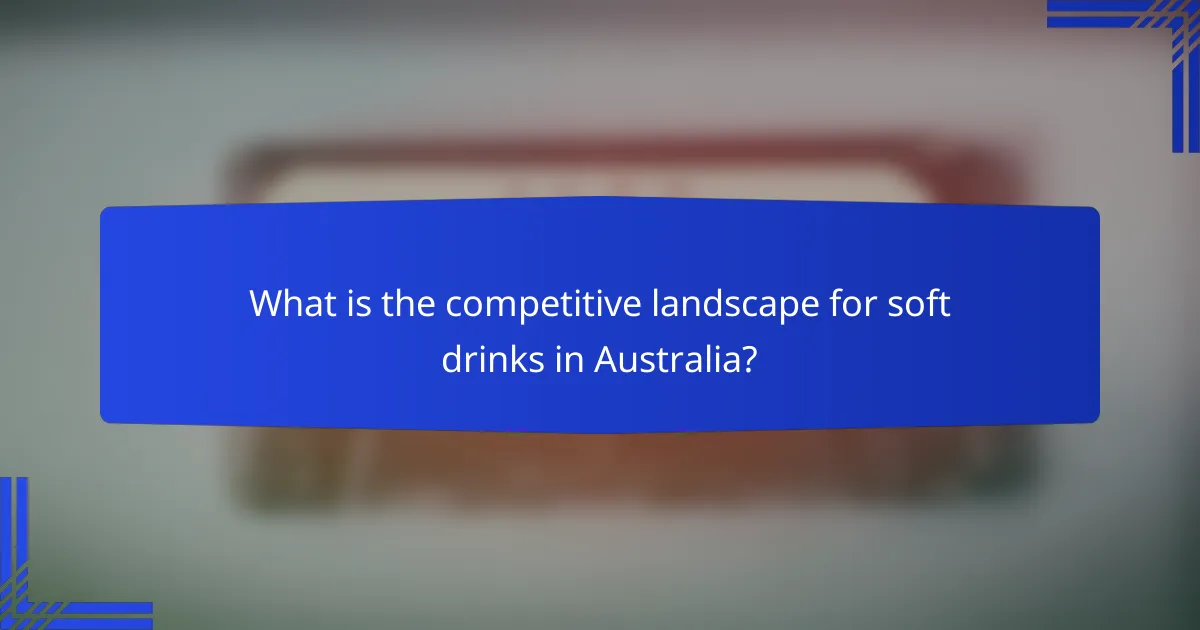
What is the competitive landscape for soft drinks in Australia?
The competitive landscape for soft drinks in Australia is characterized by a few dominant players and a variety of brands vying for market share. Factors such as distribution costs, shelf placement, and pricing strategies significantly influence competition among these companies.
Key players in the Australian market
The Australian soft drink market is primarily dominated by major companies such as Coca-Cola Amatil, PepsiCo, and Asahi Beverages. These firms have established strong brand recognition and extensive distribution networks, allowing them to maintain a significant presence in retail outlets across the country.
In addition to these giants, there are numerous smaller brands and local producers that cater to niche markets, focusing on health-conscious or premium offerings. This diversity creates a competitive environment where innovation and marketing play crucial roles.
Market share analysis
Market share in the Australian soft drink sector is heavily skewed towards the leading brands, with Coca-Cola and PepsiCo collectively holding a substantial portion of the market. Estimates suggest that these two companies account for over half of the total sales, leaving the remainder to smaller brands and private labels.
Understanding market share dynamics can help retailers make informed decisions about shelf space allocation and promotional strategies. Brands with higher market shares often benefit from better visibility and consumer trust, which can further entrench their positions.
Pricing strategies of competitors
Pricing strategies among soft drink competitors in Australia vary widely, influenced by factors such as production costs, brand positioning, and promotional tactics. Major brands often employ competitive pricing to attract consumers while maintaining profit margins through economies of scale.
Smaller brands may adopt premium pricing strategies to differentiate themselves, especially if they focus on organic or health-oriented products. Retailers should consider these pricing strategies when determining their own markup and promotional efforts to remain competitive in the market.
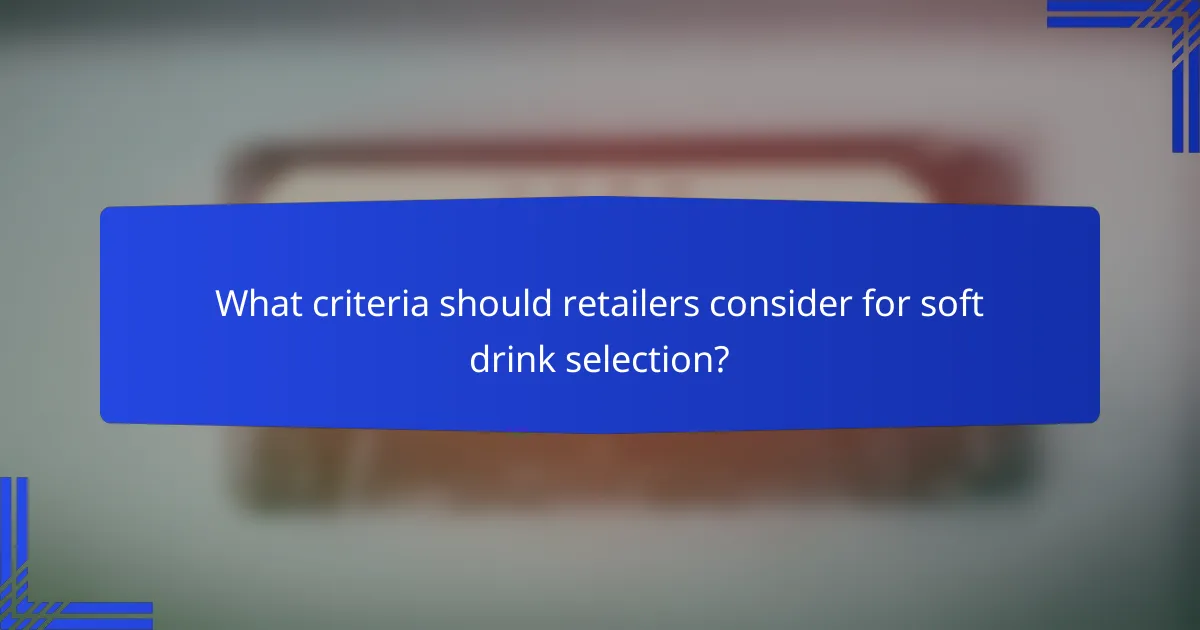
What criteria should retailers consider for soft drink selection?
Retailers should evaluate consumer preferences, brand loyalty, and profit margins when selecting soft drinks. These factors influence sales potential and overall profitability in a competitive market.
Consumer preferences and trends
Understanding consumer preferences is crucial for retailers. Trends such as health consciousness and demand for low-sugar or organic options can significantly impact selection. Retailers should regularly analyze sales data and market research to identify popular flavors and packaging styles.
Additionally, seasonal trends may affect consumer choices, with certain drinks gaining popularity during warmer months or holidays. Keeping an eye on these shifts can help retailers adjust their inventory accordingly.
Brand reputation and loyalty
Brand reputation plays a vital role in soft drink selection. Established brands often enjoy consumer loyalty, which can lead to higher sales volumes. Retailers should consider stocking well-known brands alongside emerging ones to balance customer expectations and introduce new options.
Promotions and marketing efforts can enhance brand visibility and encourage trial purchases. Retailers might collaborate with brands for in-store promotions to boost sales and attract new customers.
Profit margin expectations
Profit margins on soft drinks can vary widely, so retailers must assess their pricing strategies. Generally, soft drinks offer margins in the low to mid double digits, but this can depend on factors like supplier agreements and shelf placement.
Retailers should calculate the total cost of goods sold, including distribution and shelf placement fees, to ensure they meet their profit margin expectations. Regularly reviewing these costs can help identify opportunities for better pricing or supplier negotiations.

What are the emerging trends in soft drink retailing?
Emerging trends in soft drink retailing focus on health-conscious offerings and sustainability practices. Retailers are adapting to consumer preferences by providing healthier options and environmentally friendly packaging solutions.
Health-conscious product offerings
Health-conscious product offerings in the soft drink sector include low-sugar, organic, and functional beverages. Brands are increasingly formulating drinks with natural ingredients, reduced calories, and added vitamins or minerals to appeal to health-focused consumers.
Retailers should consider stocking these products to meet the demand for healthier alternatives. For example, beverages with less than 5 grams of sugar per serving are often favored by health-conscious shoppers, making them a smart addition to any inventory.
Sustainability in packaging
Sustainability in packaging is becoming a critical factor in soft drink retailing, as consumers are increasingly concerned about environmental impact. Brands are shifting towards recyclable materials, biodegradable options, and reduced packaging waste to attract eco-conscious buyers.
Retailers can enhance their appeal by featuring products with sustainable packaging prominently. For instance, drinks packaged in 100% recycled materials or those that use plant-based plastics can differentiate themselves in a competitive market, potentially leading to increased sales and customer loyalty.
